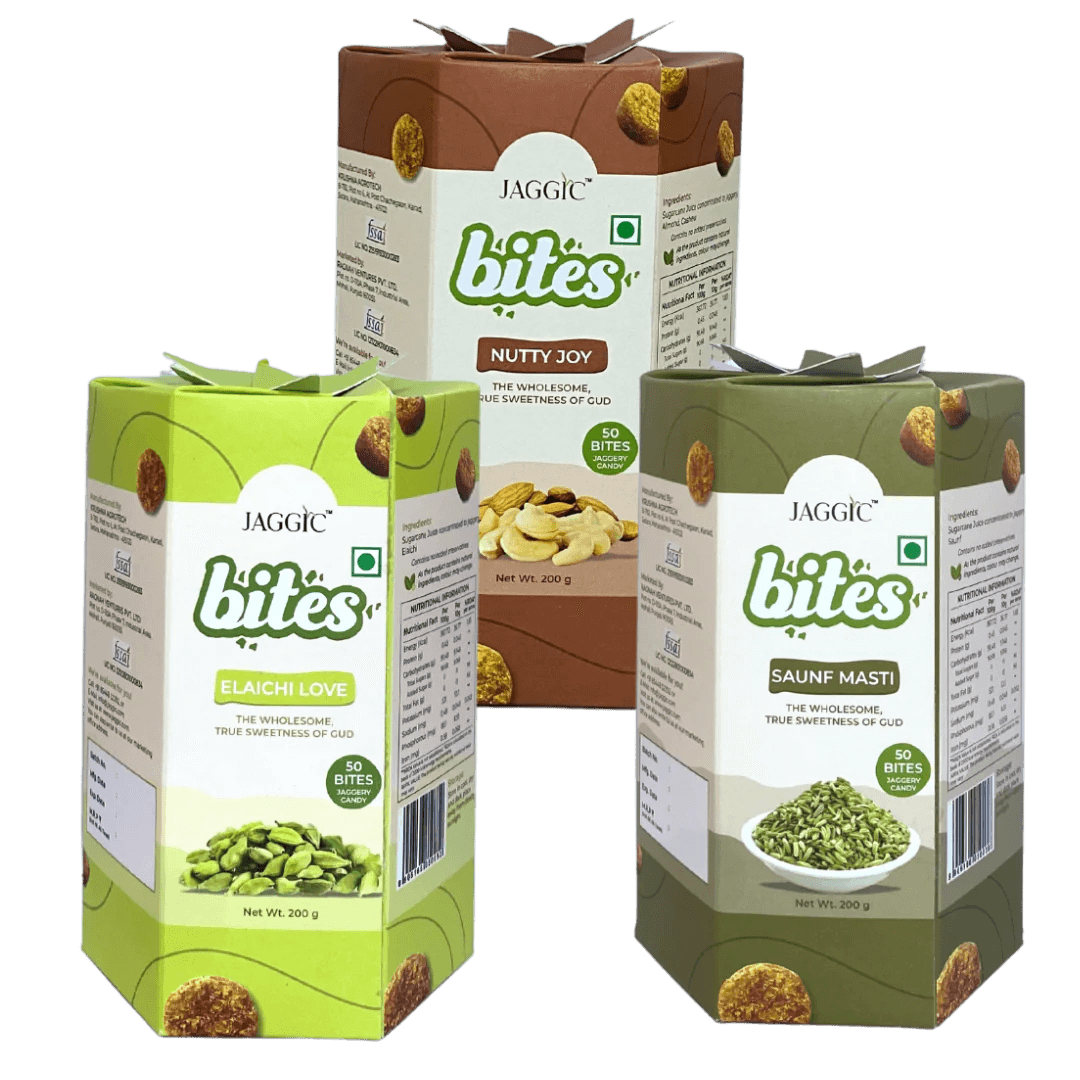Your Cart
-
${ item.product_title }₹ ${item.price}

White Sugar, Whiter Roots
Jaggery is ours, refined sugar isnot. The widespread consumption of refined white sugar is just another symptomof our colonial hangover. In the late 18th century and early19th century, British consumers preferred slave-free sugar production thanks tothe abolitionist movement. The British turned towards India to service thisdemand. Prior to the introduction of large-scale sugar mills to manufacturerefined sugar, Indians consumed unrefined, crystallized brown sugar–jaggery.

Jaggery and the Idea of India
In a country as diverse as ours, we are united by one tradition – sweets. And traditionally, the sweetener is jaggery.Travel to any corner of India, it will have a unique and special sweet dish.And, if you travel during harvest season, you will find that each state has itsown special treat associated with the harvest festival. Be it Bengal’s Patishapta or Punjab’s Gur Halwa, Assam’s Til Pitha or Sakkarai Pongal in the South, these sweets arenot only united in their festive spirit but also in their generous use ofjaggery.

The Sweet Bee in Alexander’s Bonnet
Somescholars situate the discovery of sugar-cane in Ancient India while some placeits origin further to the East. The cultivation of sugarcane and thepreparation of sugar were chronicled in texts such as the Atharva Veda circa1500-1200 BCE. Infact, the rest of the world discovered sugar after Alexander the Great invadedIndia in 327 BCE. The Macedonian described sugar as thereed that gives honey without bees.

India’s Sweet Culture
Sweets in India, are much more thana dessert.Its a good luck wish in the form ofa sugar-curd concoction fed before exams and a celebration of the outcome whenthe results come out.Sweetsare how every special occasion is celebrated and also how an ordinary moment islifted into the special.Sweets are offered to guests andGods to make them feel welcome; they are kept handy at home for a change ofmood or even just a change of taste.

Jaggery in the Ayurveda
Jaggery occupies a central role inthe Ayurveda – our home-grown, millenia old system of medicine.It has the Ushna (heat) property. Consumed dailyafter meals, Jaggery helps enhance the Agni (digestive fire) to improvedigestion. This property of jaggery also helps alleviate a loss of appetite. Jaggery’s Snighda (oily) property aids in thepassing of stools and the release of toxins from the body. This Snighda property coupled with its Ushna property, helps combat obesity.Old jaggery, which is darker and more nutritious helps to reduce symptoms of anaemia.

Medicinal Benefits of Jaggery
Sugarcanes are far more nutritiousthan you would imagine. They contain various phytochemicals which haveanti-oxidant and cholesterol-lowering properties among other health benefits.Jaggery, since it is not refined and stripped of the molasses, retains quite a few of these properties.Further, mineral salts in jaggerynot only add a hint of saltiness to the flavourprofile but also act as a cleansing agent. The consumption of jaggery cleansthe lungs, stomach, intestines, oesophagus,and respiratory tracts. In fact, jaggery is often suppliedto industrial workers to protect them from dust allergies.

Jaggery Versus Sugar
Jaggery is a more complex sugarthan its refined cousin. It is made up of longer chains of sucrose which takeslonger to digest and break down into energy. So, fewer “sugar rushes”Jaggery retains more of the mineralsalts present in sugarcane. It is also rich in iron, unlike its whitecounterpart as it is prepared in iron vessels. Thus, jaggeryis a good source of important micro-nutrients unlike its refined cousin.The minerals and molasses that givejaggery its colour alsogive it a characteristic flavour so,unlike sugar it imparts both taste and flavour tofood

A sweet tooth as old as the ages
Sweets have long been a part ofIndian culture and tradition. They signify happiness, celebration, good omens,and prosperity. The venerable Rig Veda, recorded3,500 years ago mentions a sweet dish. The ‘Apupa’was described as a flat cake made ofbarley flour, deep-fried in ghee and dipped in honey. Close enough to today’s Malpua, which could be the oldestdocumented sweet dish in the world!


Saunf Masti
Experience Saunf's goodness combined with jaggery in this delicious Saunf Masti Jaggery Candy.
Explore
Elaichi Love
Get the taste of Elaichi's resinous fragrance amalgamated well with jaggery to produce a candy.
Explore
Choco Loco
This beloved chocolate mixed jaggery candy brings you back to your childhood. It is great for both kids and adults.
Explore
Our Happy Customers

BREAKUP WITH SUGAR
Lavyaa & me, both have sweet tooth. And munching sugary candies just makes us crave more for it.Now we have a got one healthy way to #Breakupwithsugar and fight our cravings for candies and win. We came across these #organic jaggery candies from @jaggic_magic and we love it.

AN INNOVATIVE PRODUCT
Jaggery Candy is an innovative product. I love this product since I want something sweet after my every meal which is not good but since these are jaggery and comes in limited quantity, now i can eat one or two candies and control my sugar craving.